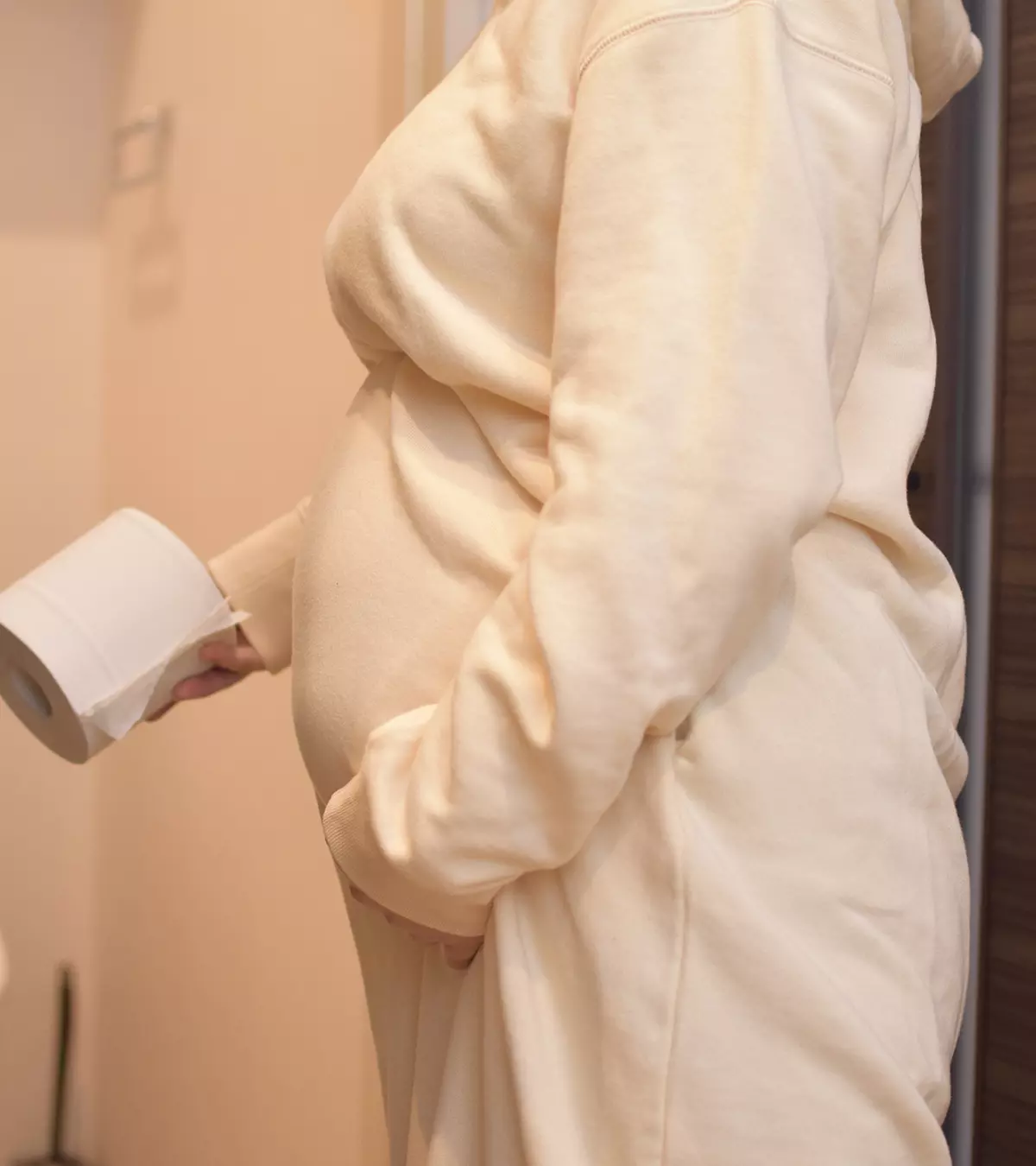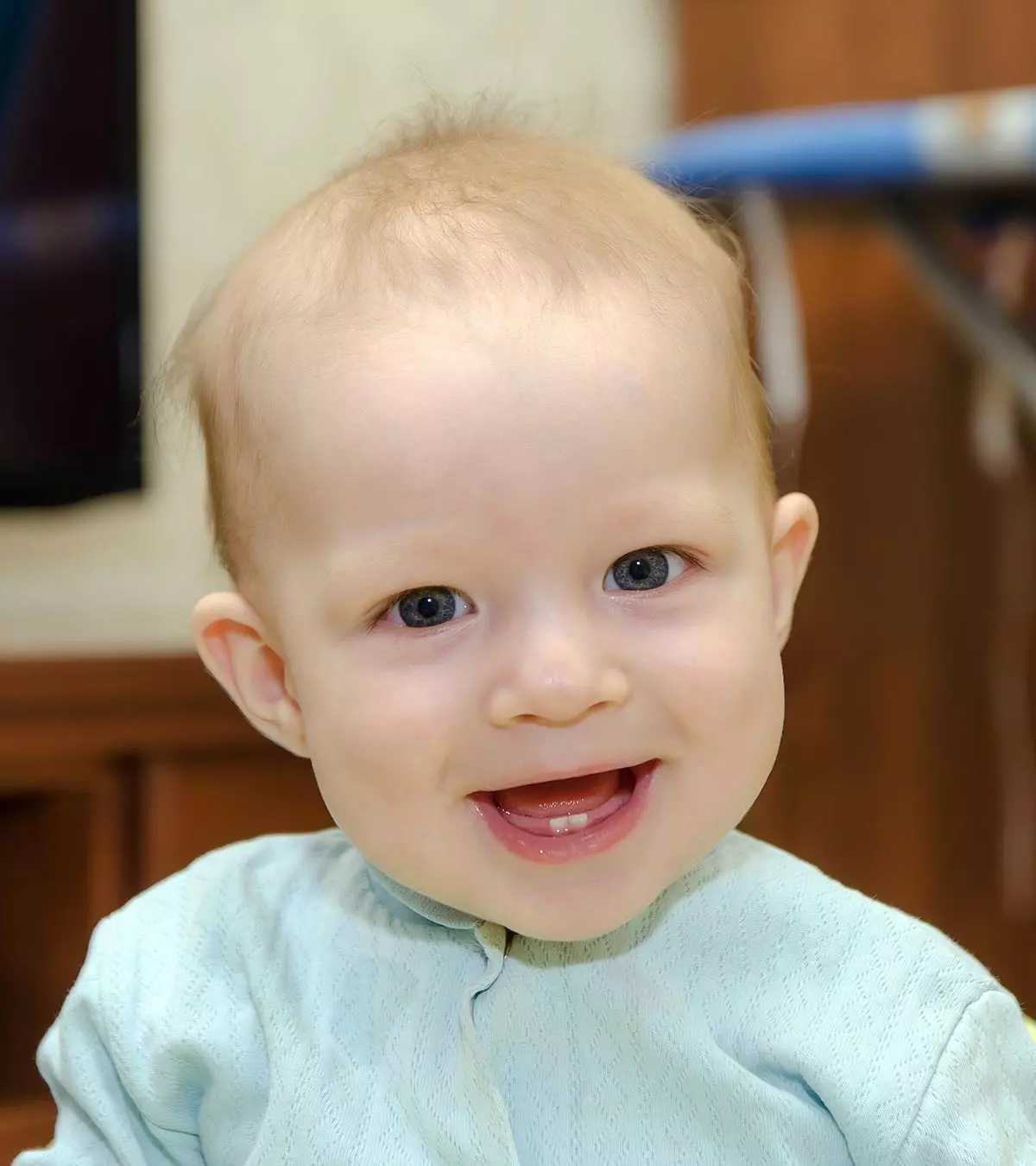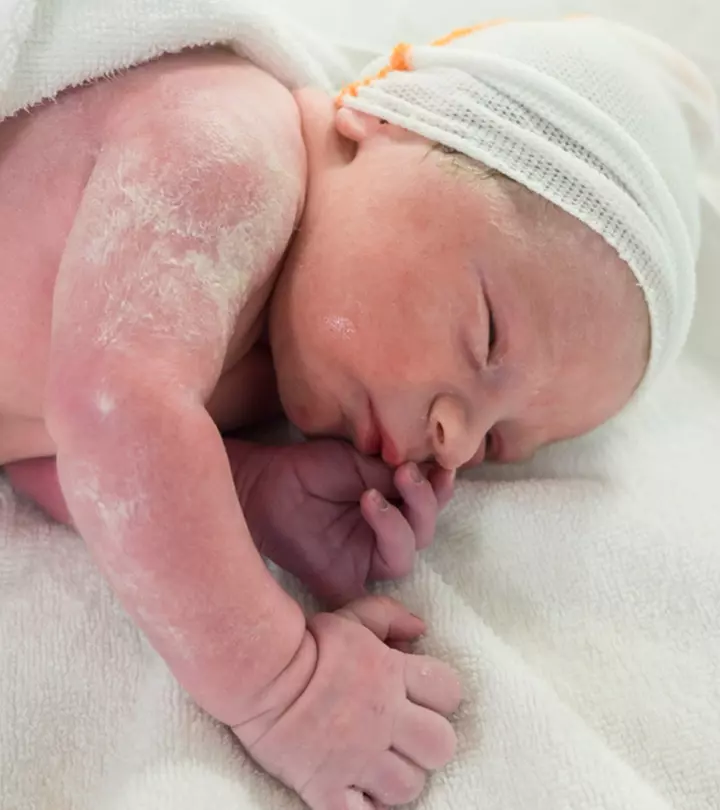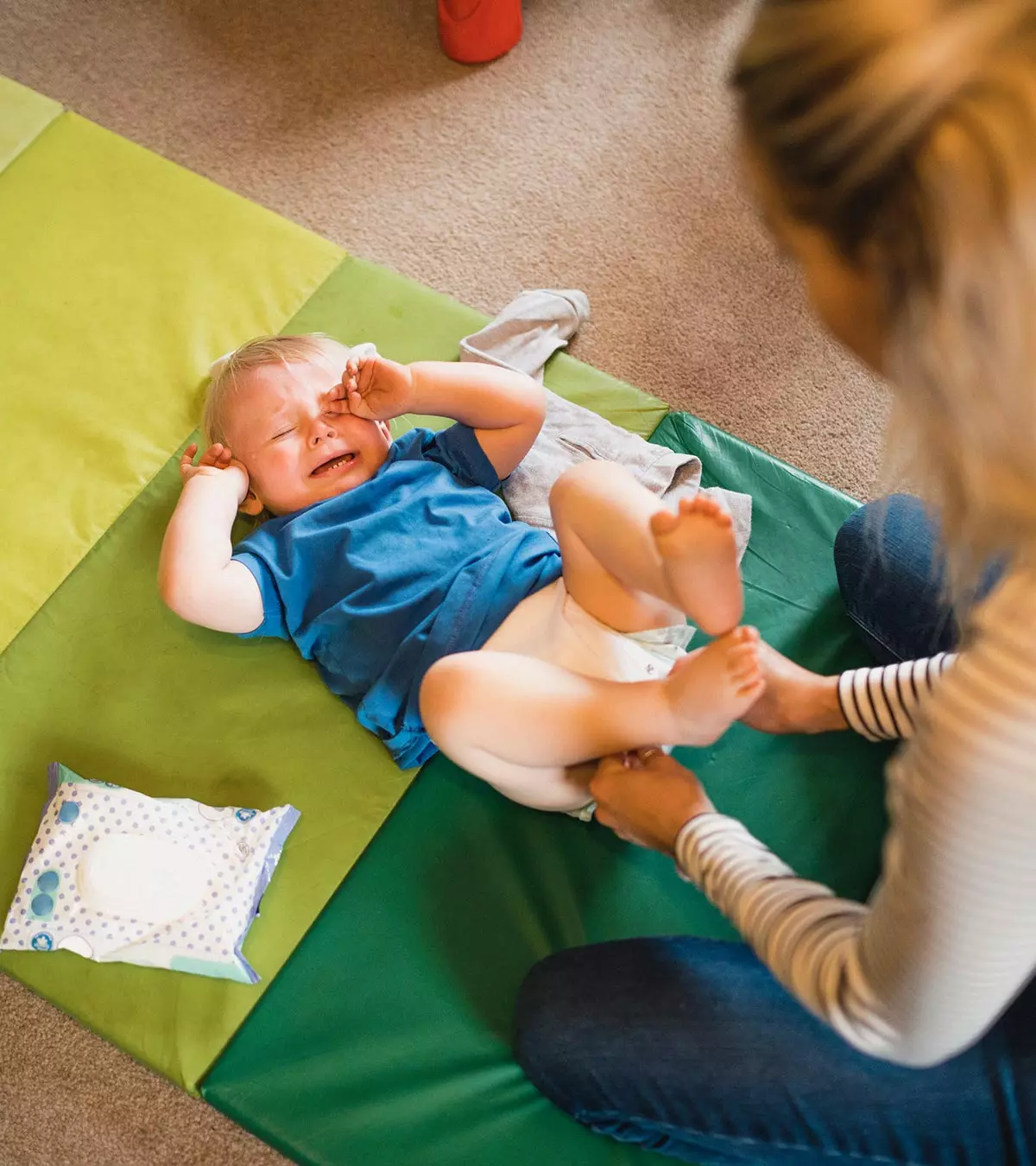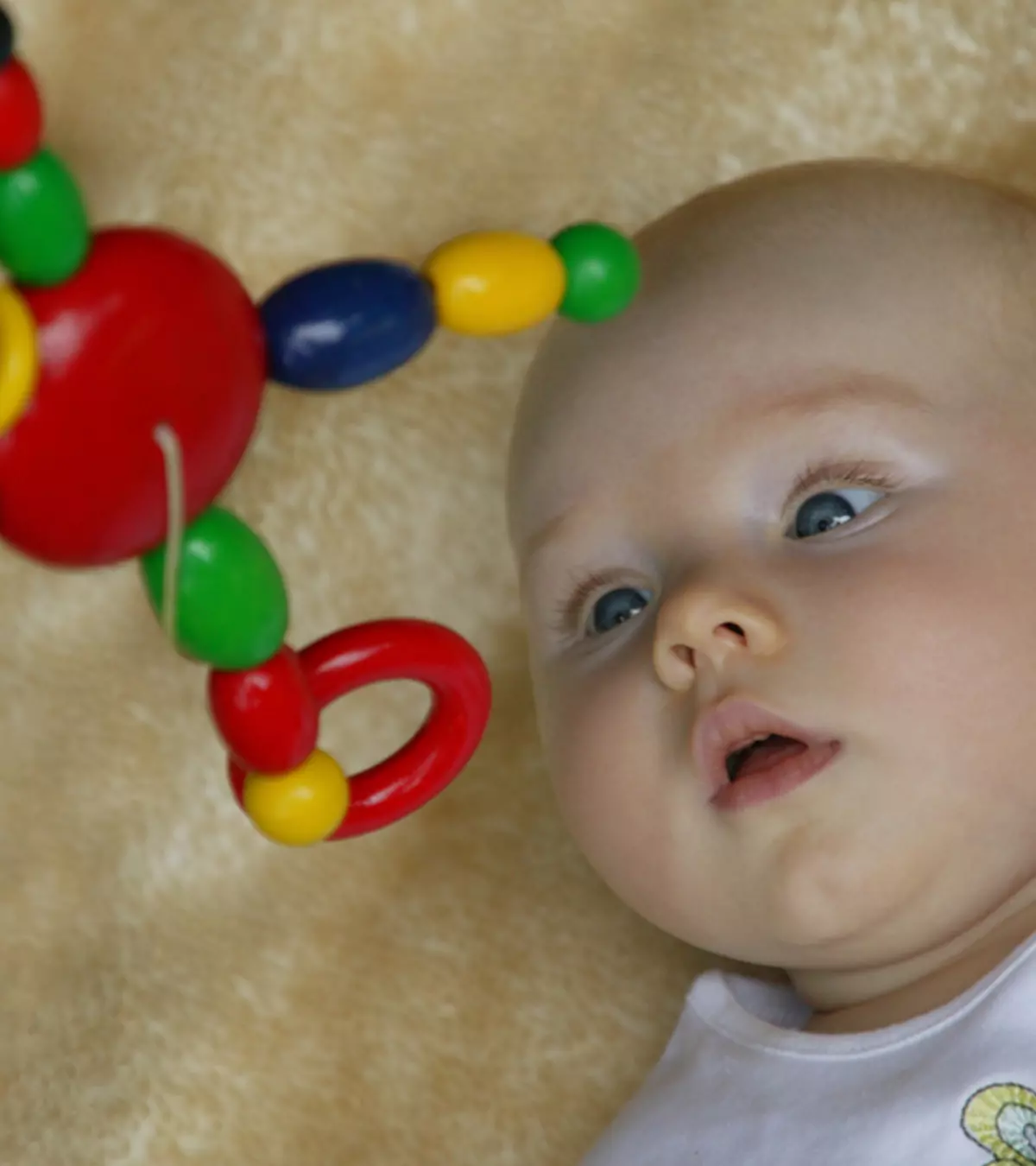
Image: ShutterStock
Soon after birth, the touch and hearing senses of babies are activated, but they can’t see colors. Since seeing colors and differentiating between them is an important milestone, many parents wonder, “when can babies see colors?”
Like any development milestone, such as crawling, walking, or talking, babies learn to see and distinguish between different colors over time. Experts say it generally takes about a year for an infant’s vision to reach the normal levels of adults and then three to four years to develop fully (1) (2). However, this may vary among babies as every baby develops at a different pace.
Read on as we share more information about babies’ color vision milestones in the first 12 months, what is the first primary color that a baby can distinguish after a few weeks and certain vision problems that you should watch out for.
Key Pointers
- Babies can see the complete spectrum of color by five months of age.
- Their vision develops in phases during the first year of life, marking a developmental milestone.
- If your baby shows symptoms such as inability to differentiate colors and acute sensitivity to light, it may indicate color blindness or possible eye problems.
When Do Babies See Colors?
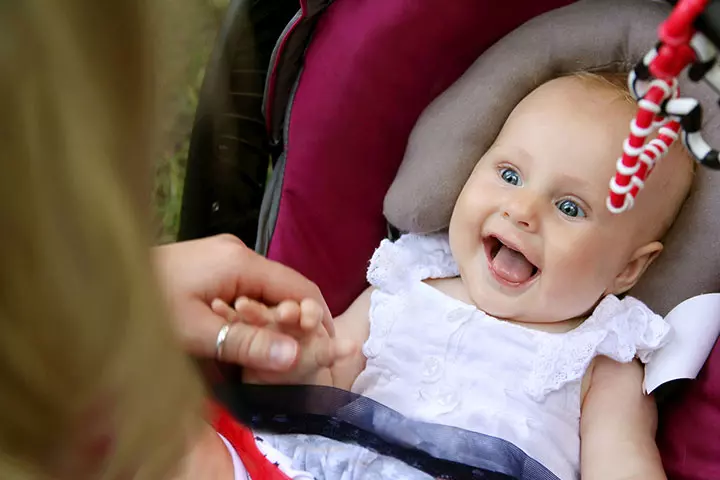
Image: IStock
A neonate’siA child under 28 days of age. eyes are slightly bigger than half the size of that of a grown-up and have limited focus, approximately eight to ten inches. The following paragraph might help you answer your question, “When do babies start seeing color?”
A newborn can differentiate between light and dark at birth. They begin to track objects in the first week, but it could take a few weeks before they see their first primary color. And it is believed that by the time they are five months old, they see the full spectrum of colors (2) (3).
What Colors Can Babies See?
Newborns can only see black, white, and shades of gray. They start to see their first primary color — red, in the first few weeks after birth and see the full spectrum of colors by five months. By the time they are 12 months, they should be able to distinguish between even the different hues and shades of colors (2).
 Quick fact
Quick fact
Image: Shutterstock
The following are the common vision-related milestones in the baby’s first year. Note that the rate at which each baby reaches these visual milestones may vary (2) (4) (5) (6).
At birth
- Blinks when their eyes are touched or in response to bright light
- Makes uncoordinated eye movements
- Focuses on an object placed as close as eight to ten inches (approximately the distance between the mother’s face and the baby when held in the arms for feeding).
- Can regard or appreciate a human face.
One to three months
- Starts to hold their gaze for a longer time and smiles when you approach closer
- Tears begin to form
- Can track a moving object up to 90 degrees
- High-contrast colored patterns and toys draw the infant’s attention
- Can recognize familiar objects
- Looks at hands
Four to six months
- Hand-eye coordination improves, thus enabling the baby to reach out to an object and hold it
- Can identify and stare at a face or an object at a farther distance
- Eyesight develops to enable color recognition
- Looks at their own hands or in the mirror
- Can turn the head and pick up a toy from the floor by the sixth month
Seven to nine months
- Depth perception (judgment regarding distance) improves
- Shows preference for certain colors
Ten to twelve months
- Can gaze at an object moving at high speed
- Memorization improves
- Can pull themselves up using support
- Can judge distance well and throw things with precision
How Do Babies See Color In The First Year Of Life?
A newborn’s vision develops rapidly during the first year of life.
Learning about how an infant grows to see the beauty of the world by developing color perception is fascinating. Here’s a rough timeline of how they see color in their first year of life (2) (6).
Birth to three months
- At birth, a neonate’s vision is poor. At first, they can see objects only in black, white, and hues of grey.
- They have an underdeveloped central vision.
- The first primary color that they see is red.
- During the second and third months, the photoreceptorsiSensory cells present in the eye that receive light and convert them into a signal to be sent to the brain. slowly develop and help the infant distinguish green and red colors within a meter’s length.
- Parents can introduce highly contrasting images or toys of these colors, including black and white, within the periphery of their view to draw their attention and develop their vision.
Four months to six months

Image: IStock
- This is considered a crucial period in the visual development of a baby, as they get introduced to other colors.
- In the fourth month, the baby starts seeing the bold primary colors, including green, red, blue, and yellow, along with certain hues of these colors.
- With the onset of binocular visioniAn ability to produce a single 3D image by combining the views collected from both the eyes. , infants recognize large geometric shapes of these colors.
- By the fifth and sixth months, their vision further develops, and they see the full spectrum of colors, including the pastels.
- They are also able to differentiate between light and dark shades to an extent.
Seven months to nine months
- The baby’s vision and depth perception improve further.
- Their visual acuityiA measure for clarity and the ability to distinguish shapes and details of vision from a distance. improves, and they see objects with better clarity.
- The baby begins to understand the three-dimensional world around them, aiding their response to different hues of colors.
Ten months to twelve months
- By one year, your baby should have accomplished chromatic vision almost similar to an adult. A slight delay is not a cause for worry.
- A one-year-old’s eyes can recognize any color and hue.
- They would have developed decent levels of visual acuity.
What Warning Signs Should Parents Watch Out For In The First Year?
As a baby’s vision develops quickly during the first year, it is crucial the parents remain attentive and look for signs of any eye or visual problem to avoid future complications.
Although vision problems are quite rare in infants, consult their optometrist promptly if you notice any of the following signs and symptoms of vision problem (5) (7).
- Abnormal alignment or movement of the eyes (usually after six months)
- Extreme light sensitivity. This might be due to increased pressure in the eyes.
- Frequent turning of the eyes
- Poor visual tracking
- Redness of the eyes
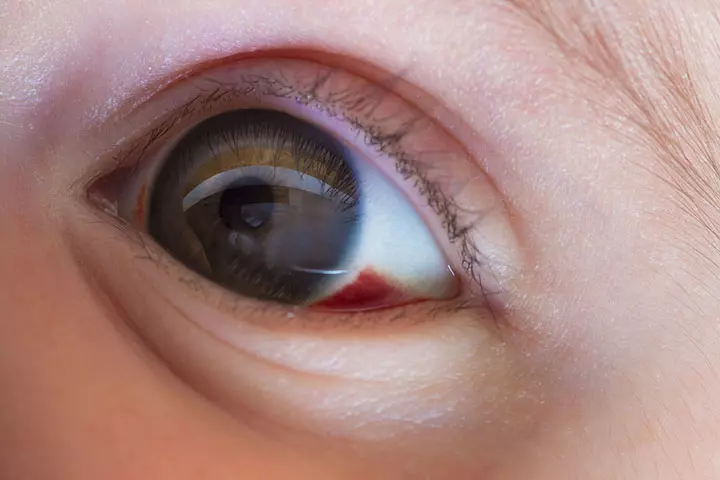
Image: IStock
- Teary or watery eyes
- Inability to focus on familiar objects
- Grey or white pupil
- Not able to focus on objects or follow them by two months
Parents should take their infants for regular eye exams to determine the baby doesn’t suffer from eye problems such as strabismus and nystagmus (8) (9).
Crossed eyes (Strabismus)
- It is a kind of misalignment of an eye.
- The squinting might not only be inward, but also upward, downward, or outward.
- When left untreated, it could lead to amblyopiaiA medical condition characterized by improper vision development during childhood in one or both eyes. .
 Did you know?
Did you know?Nystagmus
- It refers to the fluttering of the eyes, wherein they oscillate rapidly in horizontal, vertical, or circular motion and is often characterized by blurriness.
- Nystagmus can be congenital or acquired and may be noticed around six weeks to several months in the newborn.
- If an abnormal development of the optic nerve is the cause of nystagmus, the baby may have poor vision.
When Do You Know If The Baby Is Color Blind?
The baby’s inability to recognize colors such as red, green, brown, or orange indicates color blindness.
The symptoms of color blindness generally become apparent when your baby is in pre-school. You could suspect color blindness if your infant is extremely sensitive to light and has excellent night vision.
Consult your infant’s optometrist to rule out eye problems, such as glaucomaiA condition that may lead to a loss of vision due to nerve damage resulting from increased pressure. , macular degenerationiProblems with central vision resulting from damage to a part of the retina. , cataracts, or diabetic retinopathy, which could be risk factors (10) (11).
 Quick fact
Quick factDoes My Baby Need An Eye Doctor Yet?
Routine eye checkups are a must to ensure the perfect eye health of your baby.
According to the American Academy of Ophthalmology and the American Academy of Pediatrics, newborns, especially premature babies or ones with a family history of eye disorder, should be examined for general eye health by the pediatrician in the hospital nursery to rule out infections, defects, cataracts, or glaucoma. And at six months, the baby’s eyes should be checked for alignment and vision maturity as part of the well-child visits (11).
Frequently Asked Questions
1. Why is red the first color that babies see?
Retinal cone photoreceptors are responsible for color vision in humans. These receptors are of three types with sensitivities to long (L-cones sensitive to reddish light), medium (M-cones sensitive to greenish light), and short wavelengths (S-cones sensitive to bluish light), respectively. Research suggests that the red-green color mechanisms are first to develop in infants, possibly making them see red color first (12).
2. What order do babies see colors?
At about one week after birth, babies may see colors such as red, orange, yellow, and green. It might take them a little longer to see blue and violet (13).
3. Do babies prefer bright colors?
Yes, babies are attracted to bright colors once their color perception develops. They also like to look at human faces, contrasting patterns, and moving objects. Black-and-white pictures or objects may hold your baby’s interest longer than those with lots of similar colors (14)
4. How can parents support vision development?
Parents can help their baby’s vision develop by using high-contrast toys to capture their attention and showing colorful images to stimulate their visual interest.
5. How can I tell if my baby is seeing well?
Signs of healthy vision in babies include following moving objects with their eyes and reacting to bright colors.
“When can babies see color?” This is a common question most parents may have while tracking their infant’s vision-related milestones. Vision development is rapid in babies during the first year of their lives, and they may begin to differentiate between light and dark soon after birth. Yet, it will take a few weeks for babies to perceive different colors. Nonetheless, you must promptly take your baby for regular checkups and track their vision-related milestones in the first year. Do not delay contacting a pediatrician or optometrist if you notice any vision problems in your baby.
Infographic: Preferred Colors For Baby Toys
Babies undergo rapid development in their vision during the initial months. Furthermore, play facilitates the fostering of new skills in babies. This infographic details how you may stimulate your baby’s visual and sensory developments by choosing high-contrast toys for their playtime. Illustration: Momjunction Design Team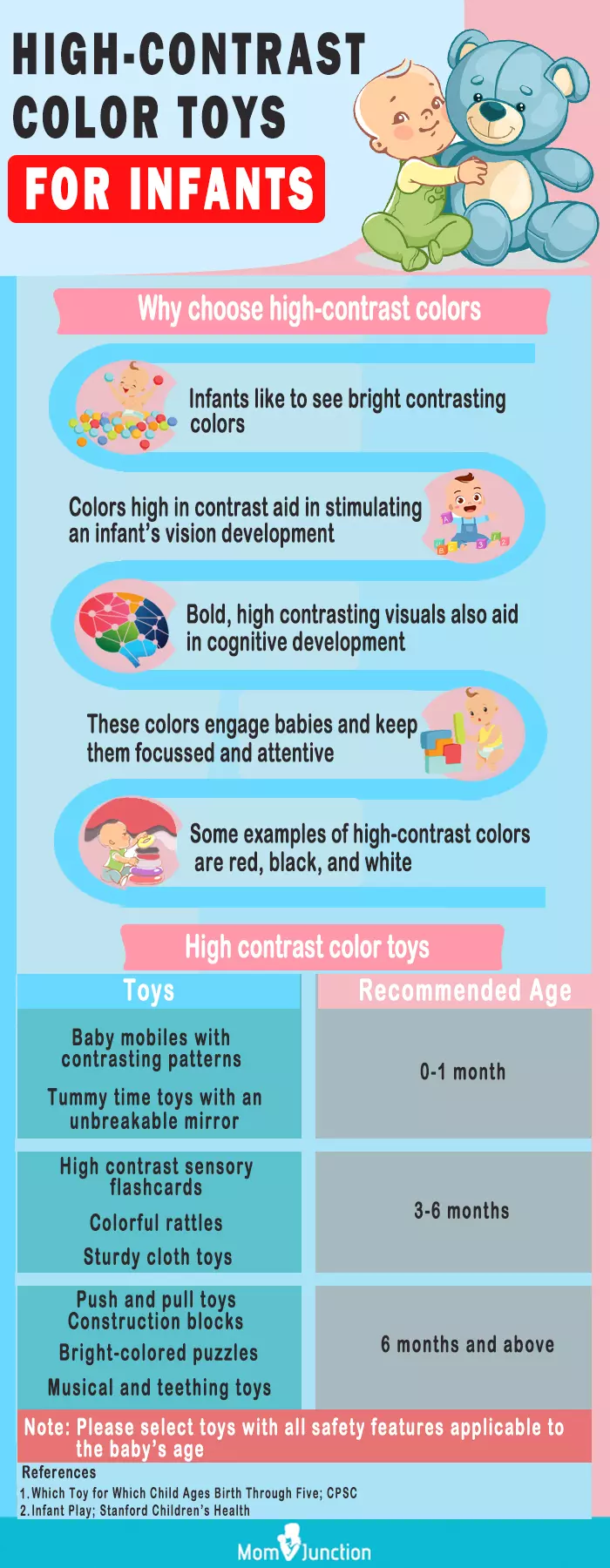
Illustration: When Do Babies See Color And Other Vision Milestones

Image: Stable Diffusion/MomJunction Design Team
Your baby’s vision will start to improve in the first few months of life. Learn when to expect clearer vision and how to help your baby’s development.
References
1. Infant Vision Development: What Can Babies See?; American Academy of Pediatrics
2. Your Baby’s Eye Development; Bausch & Lomb Incorporated
3. Newborn-Senses; Children’s Hospital of Philadelphia
4. Vision Milestones; Johns Hopkins Medicine
5. Infant Vision: Birth to 24 Months of Age; American Optometric Association
6. Infant Vision Birth to One Year; The Nationwide Children
7. Your Child’s Vision; The Nemours Foundation
8. Strabismus; American Association for Pediatric Ophthalmology and Strabismus
9. Nystagmus; American Association for Pediatric Ophthalmology and Strabismus
10. Spotting the Early Symptoms of Colour Vision Deficiency in Children; Colour Blind Awareness
11. Color Blindness; Regents of the University of Michigan
12. Infant color perception: Insight into perceptual development; Society for Research in Child Development
13. Eye Development in Babies; Children’s Hospital, Los Angeles
14. Your Newborn’s Hearing, Vision, and Other Senses; KidsHealth
15. Newborn Senses; Stanford Medicine Children’s Health
16. Strabismus; The Nemours Foundation
17. Color Blindness; Cleveland Clinic
Community Experiences
Join the conversation and become a part of our nurturing community! Share your stories, experiences, and insights to connect with fellow parents.
Read full bio of Dr. Anuradha Bansal
Read full bio of Rohit Garoo
Read full bio of Dr. Ritika Shah
Read full bio of Vidya Tadapatri






